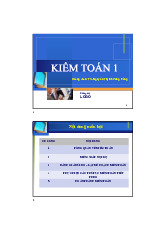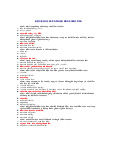






Preview text:
Question 1: A newly set up dot-com entity has engaged you as its financial advisor. The entity has
recently completed one of its highly publicized research and development projects and seeks your advice
on the accuracy of the following statements made by one of its stakeholders. Which one is it?
A. Training costs of technicians used in research can be capitalized.
B. Cost incurred during the “research phase” can be capitalized.
C. Designing of jigs and tools qualify as research activities.
D. Cost incurred during the “development phase” can be capitalized if criteria such as technical
feasibility of the project is being established are met.
Question 2: Which item listed below does not qualify as an intangible asset?
A. Copyrights that are protected B. Registered patent C. Notebook computer D. Computer software
Question 3: Which of the following items qualify as an intangible asset under IAS 38?
A. Advertising and promotion on the launch of a huge product.
B. College tuition fees paid to employees who decide to enroll in an executive M.B.A program at
Harvard University while working with the company.
C. Legal costs paid to intellectual property lawyers to register a patent.
D. Operating losses during the initial stages of the project.
Question 4: Once recognized, intangible assets can be carried at:
A. Cost less accumulated impairment.
B. Cost plus a notional increase in fair value since the intangible asset is acquired.
C. Revalued amount less accumulated impairment.
D. Cost less accumulated impairment and less accumulated amortization.
Question 5: Which of the following disclosures is not required by IAS 38?
A. Contractual commitments for the acquisition of intangible assets.
B. Fair value of similar intangible assets used by its competitors.
C. Reconciliation of carrying amount at the beginning and the year-end.
D. Useful lives of the intangible assets.
Question 6: The definition of an intangible asset comprises: (i) Identifiability (ii) Control over a resource
(iii) Existence of future benefits (iv) Residual value A. (i), (ii) and (iii) B. (i) and (ii) only C. (i), (ii), (iii) and (iv) D. (i) and (iii) only
Question 7: An undertaking can choose either the cost option or the revaluation option, as its accounting
policy. It must apply the chosen model to: A. An item of intangible asset B. Major assets
C. An entire class of intangible assets D. All intangible assets
Question 8: Using the revaluation option, can fair values be estimated, if there is no market-based evidence?
A. Yes, if the asset is specialised and rarely sold, by using an income, or a depreciated replacement cost approach
B. Yes, if expert valuation is available
C. Yes, if the asset is specialised and rarely sold, by using indexation D. No Question 9: Control is:
A. (a) Power to obtain benefits from a resource
B. Both (a) and (b) are required
C. Any of (a) and (b) is required
D. (b) Power to restrict access of others to the resource
Question 10: Research costs can be capitalised:
A. When the development stage has begun
B. When the development stage is complete C. Always D. Never
Question 11: Which of the following is an objective of IAS 38?
A. To prescribe the accounting treatment for intangible assets that are dealt with specifically in another Standard
B. To specify how to measure the fair value of intangible assets
C. To specify disclosure requirements about intangible assets D. All of the above
Question 12: Which of the following shall be excluded from the scope of IFRS 16 Leases and shall be
accounted in accordance with IAS 38? [38.6] A. Motion picture films B. Patents and copyrights C. Manuscripts D. All of the above E. None of the above
Question 13: If an asset incorporates both intangible and tangible elements, it shall be treated under __________.
A. IAS 16 Property, Plant and Equipment B. IAS 38 Intangible Assets
C. A or B, depending which element is more significant D. A and B
Question 14: Which of the following does not define an “asset”?
A. A resource that is controlled by an entity as a result of past events
B. A resource which value in use exceeds its historical cost
C. A resource from which future economic benefits are expected to flow to the entity D. All of the above E. None of the above
Question 15: Are the following statements true or false, according to IAS38 Intangible assets? (1)
The cost of an asset should include the amount of any cash or cash equivalents paid to acquire the asset. (2)
The cost of an asset should include non-cash consideration measured at fair value. Statement (1) Statement (2) A False False B False True C True False D True True
Question 16: The Markab Company has acquired a trademark relating to the
introduction of a new manufacturing process. The costs incurred were as follows: Cost of trademark CU3,500,000
Expenditure on promoting the new product CU50,000
Employee benefits relating to the testing of the
proper functioning of the new process CU200,000
According to IAS38 Intangible assets, what is the total cost that
should be capitalised as an intangible non-current asset in respect of the new process? A CU3,750,000 B CU3,700,000 C CU3,500,000 D CU3,550,000
Question 17: In IAS 38, an 'identifiable non-monetary asset without physical substance', is the definition of: A. an intangible asset B. cash at bank C. goodwill D. none of the above Question 18:
Which of the following is a necessary factor relating to the existence of an intangible asset?
A. Disclosure in financial statements B. Classification C. Liquidity
D. Existence of future economic benefits
Question 19: An example for intangible assets are ... A. Brands B. Money in bank accounts
C. buildings used for rental income
D. machines which are no longer used in production Question 20: What is correct?
A. Acquired brands are always recognized because it is assumed that they generate future economic benefits
and their cost can be measured reliably
B. Self-generated brands that will be sold in the future are recognised because they will generate future economic benefits
C. Acquired brands are only recognised if they are generated in the development pahse and fulfuill 6 criteria
D. Self generated brands are only recognised if they are generated in the development phase and fulfill 6 criteria
Question 21: if an entity cannot distinguish research phase and development phase A. all costs are capitalised B. all costs are expended
C. all costs are capitalised if 6 requirements are fulfilled
D. all costs expended if 6 requirements are fulfilled
Question 22: Which of the following intangible assets cannot be recognized if it is self-generated? A. Computer software B. Patented technology C. Brands D. Motion pictures
Question 23: The definition of intangible assets according to IAS 38 does not require … A. … identifiability. B. … non-monetary asset.
C. … future economic benefits can be measured reliably D. … no physical substance.
Question 24: The impairment only approach is used for … A. … inventories.
B. … intangible assets for which an active market exists.
C. … intangible assets with an indefinite useful life.
D. … intangible assets resulting from development costs.
Question 25: For which of the following assets can an active market exist? A. Patents. B. Motion picture. C. Trademarks. D. Production quotas.
Question 26: Which of the following measurement models is not permitted for the subsequent
measurement of intangible assets under IAS 38? A. Cost Model.
B. Capital Asset Pricing Model. C. Revaluation Model.
D. All aforementioned are permitted.
Question 27: Where is the amortisation of an intangible asset recognised? Profit or Loss Equity
Statement of Financial Position Statement of Cash Flows
Question 28: Which of the following are development costs?
A. A firm searches for a new process to produce batteries for electric vehicles.
B. A firm buys a license for a new process to produce batteries for their electric vehicles.
C. A firm searches for applications of new research findings of TUM to develop a new process to produce
batteries for their electric vehicles.
D. A firm uses a prototype which was developed by TUM to develop new batteries for electric vehicles.
Question 29: Which of the following does not have to be fulfilled in order to recognize development costs?
A. technical feasibility of completing the intangible asset for use/sale.
B. ability to measure reliably the expenditures.
C. ability to monitor the development process.
D. intention to complete the intangible asset.
Question 30: Intangible assets are measured at the balance sheet date using … A. … the cost model only.
B. … the fair value model only.
C. … the revaluation model only.
D. … the cost model or in the case of an active market the revaluation model.
Question 31: For which assets is the impairment test never relevant? A. Inventories.
B. Intangible assets with definite useful life.
C. Property, plant and equipment.
D. Intangible assets with indefinite useful life.
Question 32: Which of the following assets can have a indefinite useful life? A. Patents. B. Computer software. C. Trademarks. D. Machines.
Question 33: An intangible asset with a finite useful life should be amortised over: A. Its expected useful life
B. A period at the discretion of management C. Five years D. No foreseeable limit




